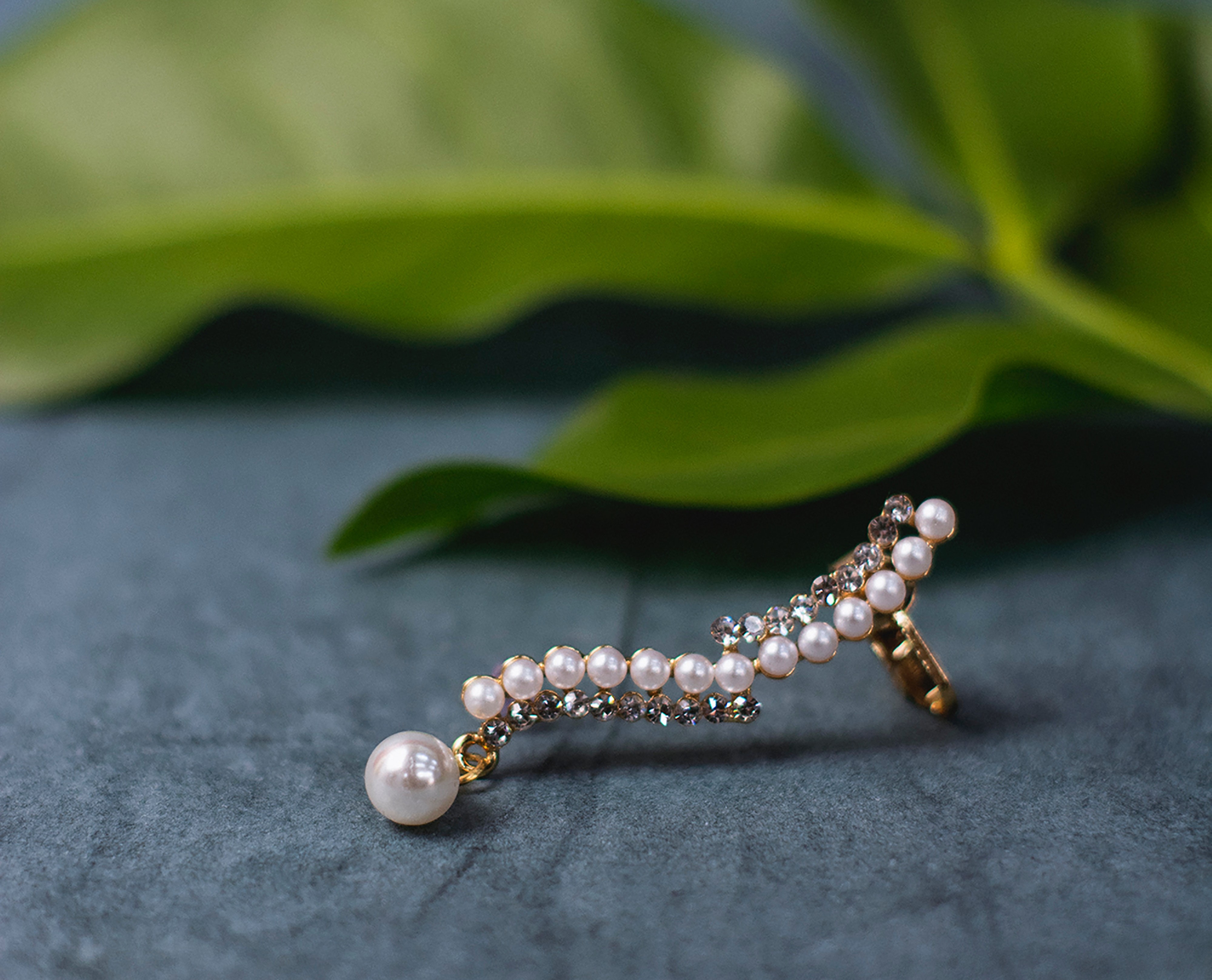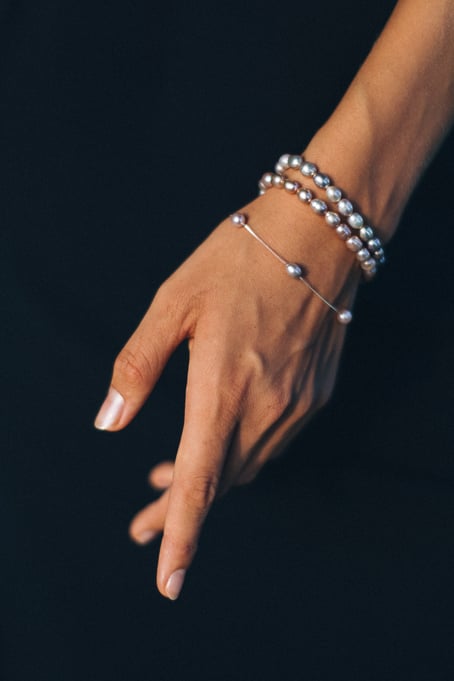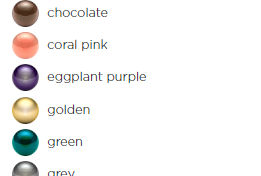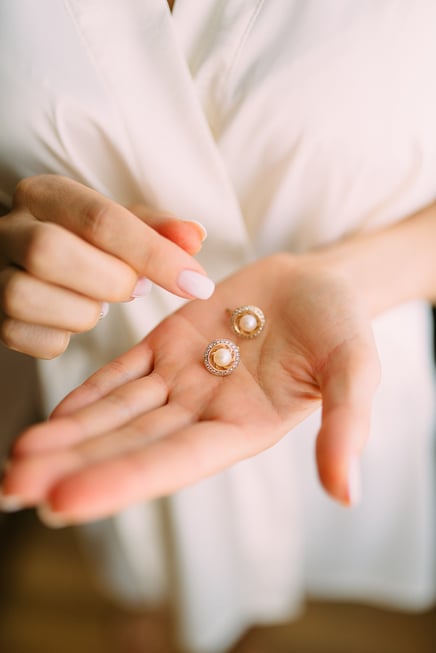
Known as the Queen of Gems, pearls have been coveted for centuries across many civilizations, and have a particularly unusual creation process. A pearl is formed when an irritant, such as a parasite or piece of shell, becomes accidentally lodged in an oyster's soft inner body, causing it to secrete a crystalline substance (called nacre) as a defense mechanism, which builds up around the irritant in layers. This phenomenon creates what we refer to as pearls.
Types of pearl
Natural Pearls
Natural pearls form in the bodies, or mantle tissue, of certain mollusks, without human intervention. Today, natural pearls are very rare as pearl-producing mollusks were nearly driven to extinction due to overharvesting in the 18th and 19th centuries.
Cultured Pearls
Cultured pearls require human intervention and care, with most of the mollusks used in the culturing process today being raised specifically for that purpose, although some wild mollusks are still collected and used.
There are four major types of cultured whole pearls:
Akoya Cultured Pearls
Akoya cultured pearls are the most familiar type of saltwater cultured pearl. Many customers think of white or cream colored akoyas as the classic pearl used for jewelry, especially single-strand necklaces. Japan and China both produce akoya cultured pearls.
South Sea Cultured Pearls
Australia, Indonesia, and the Philippines are leading sources of these saltwater cultured pearls. South Sea cultured pearls can be white to silver or golden, depending on the type of oyster. Their large size, thick nacre, and their limited critical growing conditions are all factors contributing to their value.
Tahitian Cultured Pearls
Cultivated primarily around the islands of French Polynesia (the most familiar of these is Tahiti), these saltwater cultured pearls, sometimes referred to as black pearls, have a wide color range. They might be gray, black or brown, and they can have blue, green, purple or pink overtones.
Freshwater Cultured Pearls
Freshwater cultured pearls are the most commonly produced pearls and are one of the most popular pearl types among shoppers and jewelry designers. This is due to their remarkable range of sizes, shapes and colors, plus their commercial availability at lower price points. They are usually cultured in freshwater lakes and ponds, often with many pearls grown in one oyster. China is the leading source for freshwater cultured pearls.

A quick guide to pearls
| Specification | Details |
| Rare Colors | Gold |
| Popular Cuts | Round and Near-Round |
| Hardness | 2.5 - 4.5 on Mohs Hardness |
Country of origin
Top exporters of Pearl include:
- Japan
- Indonesia
- China
- Hong Kong
- Australia
The pearl color spectrum
Natural and cultured pearls occur in a variety of colors, but the most familiar and most commonly associated with pearls are white and cream. Black, gray, and silver are also increasingly common, but the palette of pearl colors extends to every hue. The main color of the pearl is often modified by additional colors called overtones, which are typically pink (sometimes called rosé), green, purple, or blue. Some pearls also show an iridescent phenomenon known as orient.

Common shapes and notes on durability
Pearls can come in a variety of shapes - round, oval, pear, semi-round, button, baroque, drop, and circle. When first used in jewelry, only the finest cultured pearls were faceted, but today pearls of all qualities and sizes are cut and polished. Common cuts can be fancy, full-drilled, or half-drilled.
Pearls rank between 2.5 and 4.5 on the Mohs Hardness scale. They are soft and easily scratched, therefore great care should be taken with jewelry containing pearls. Aging, dehydration, and excessive bleaching can further cause pearls to become more fragile.

The long history of pearls
Pearls were discovered before written history began, so it is hard to attribute their discovery to one particular time or place. However, they have been worn as a form of jewelry for millennia - identified due to a fragment of pearl jewelry found in the sarcophagus of a Persian princess that dates back to 420 BC.
Pearls were presented as gifts to Chinese royalty as early as 2300 BC, while in ancient Rome, pearl jewelry was considered to be the ultimate status symbol. In fact, pearls were so highly valued that in the 1st century BC, Julius Caesar passed a law limiting the wearing of pearls only to the ruling classes.
The abundance of natural oyster beds in the Persian Gulf meant that pearls also carried great importance in Middle Eastern cultures, where legend stated that pearls were formed from dewdrops that were swallowed by oysters when they fell into the sea. Before the advent of cultured pearls, the Persian Gulf was at the center of the pearl trade and pearls were a source of wealth in the region long before the discovery of oil.
Legends surrounding pearls
With such ancient history surrounding it, the pearl has also been shrouded in myth and mystery.
Legend states that Cleopatra crushed a pearl into a glass of wine to prove to Marc Antony that she could give the most expensive dinner in history. Ancient Romans imagined they were the tears of gods and angels; the ancient Chinese thought they offered protection from fire-breathing dragons, and said that the use of pearl jewelry symbolized the purity of the wearer. Europeans believed they symbolized modesty, chastity, and purity, and in the Dark Ages, knights often wore pearls on the battlefield, believing that the precious gemstones would keep them safe.

The rise of pearls in jewelry
In the 20th century, the classic cultured pearl necklace became an essential fashion accessory, adorning icons of sophistication like Jackie Kennedy Onassis, Audrey Hepburn, and Coco Chanel, driving a resurgence of interest in pearls for all consumers. The 1980s and 90s were characterized by the popularity of large, lustrous pearls that were often used in statement necklaces, earrings, and bracelets. Cultured pearls, which were more affordable than natural pearls, also became increasingly popular during this time.
In the early 21st century, the trend for pearls turned to focus on more delicate and minimalist designs, as seen in the popularity of pearl drop earrings and simple, single-pearl necklaces. Another trend that emerged during this time was the use of colored pearls, including black, pink, and lavender pearls in jewelry designs.
In the last decade, there has been a move towards combining pearls with other materials, such as metals, crystals, and beads, resulting in unique and eclectic designs that incorporate pearls in a variety of ways.



